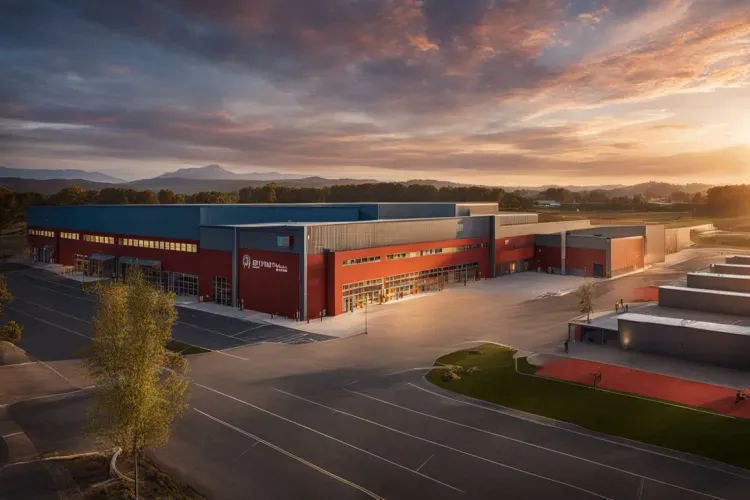Are you wondering how to make your money work harder for you? Investing in industrial real estate is a smart move. Our guide shows you the ropes, from spotting great investments to understanding costs.
Keep reading, and let’s unlock some secrets together.
Understanding Industrial Real Estate

Industrial real estate means places for making, storing, and sending goods. From big buildings to special lands, each has its own use and cost.
Defining Industrial Real Estate
Industrial real estate involves land and buildings used for making, storing, and shipping goods. Think of large warehouses, factories, and distribution centers. These places are vital for businesses that make products or need to store lots of items before sending them to stores or customers.
From my own experience working in the field, I’ve seen how these properties play a key role in the supply chain. They help companies keep their operations smooth by having enough space for production lines or keeping goods safe until they’re ready to move.
This type of real estate is different from others because it’s all about business needs. It’s not like shopping malls or office spaces where people shop or work at desks. Here, the focus is on machines, storage racks, and loading docks for trucks.
Investing in industrial properties means understanding these unique features and what makes a good space for manufacturing or logistics. Knowing about things like ceiling heights for machinery or floor strength can make a big difference in choosing the right property.
Different Class types: Class A, B, and C Industrial
Class types in industrial real estate offer a wide range to fit different investor needs. They categorize properties based on factors like age, location, and condition. Here’s a quick glance:
| Class Type | Features | Investor Profile |
|---|---|---|
| Class A | Modern buildings in prime locations with high-quality tenants. Top-notch condition. | Suitable for investors looking for low risk and steady income. |
| Class B | Older buildings that might need minor upgrades. Good locations. | Great for those aiming for value-add opportunities. |
| Class C | Outdated structures in less desirable areas. Requires significant upgrades. | Fits investors ready for a challenge and high-risk, high-reward scenarios. |
From my journey in the field, I learned the hard way that choosing the right class needs deep thought. You look at your budget, yes. But you also think about how much time and money you’re ready to spend on improvements. Class A sounds easy — it’s almost like buying a ready-to-eat meal. But, the cost! It’s high. Then, Class B and C… they’re like a meal kit. Cheaper, but you must cook.
I’ve seen Class B properties shine with some TLC, turning into real moneymakers. It’s thrilling to watch a place transform and to know you played a part in that. And let’s not forget, sometimes Class C is the diamond in the rough. High-risk, but oh, the rewards can be sweet.
Choosing where to put your money in industrial real estate is no small feat. Your decision molds your future in this bustling market. Whether it’s a sleek, modern Class A building, a sturdy Class B with potential, or a challenging Class C fixer-upper, each class has its perks. The key? Knowing your limits, your goals, and the pulse of the market. Happy investing!
Types of Industrial Real Estate

Industrial real estate includes many types, each serving a different purpose. From lands used for building to big storage spaces, there’s something for every need in this sector.
Industrial Land
Buying land for industrial purposes is a key step in growing your investment portfolio. This type of land is where factories, warehouses, and distribution centers sit. It’s the starting point for making products or storing goods before they reach stores or homes.
My own journey into investing in industrial land showed me its value firsthand. It’s not just about finding a big piece of dirt; it’s about seeing its potential to host businesses that make or move products.
You need to think about location, size, and what the city allows you to build there. Good spots are close to highways and have enough space for large buildings and trucks to move around easily.
And before you buy, check the rules. Some places have strict limits on what you can build or how you can use the land. Keep these tips in mind, and investing in industrial land could be a smart move for your real estate career.
Bulk Warehouse
Bulk warehouses are big buildings used for storing lots of goods. These places are important for businesses that need to keep products before they send them out to stores or customers.
They have a lot of space, sometimes as big as several football fields. This makes them perfect for holding items in large quantities.
These warehouses also help in moving goods quickly. They have special areas for trucks to come and go, making it easy to get products in and out fast. Businesses look at this kind of warehouse when they want to store a lot of items and move them without delay.
This is why investing in bulk warehouses can be a smart move for people looking into industrial real estate.
Heavy Manufacturing
Heavy manufacturing involves big spaces for making large products. Think of places where they build machines or vehicles. These factories need heavy-duty floors to support massive equipment.
They also have high ceilings for tall machinery. This type of industrial real estate is special because it’s built to handle a lot of weight and power.
Investing in these properties can be very profitable. They often come with long-term leases since moving these huge operations is hard and costly. For real estate agents, knowing the needs for heavy manufacturing can set you apart.
You’ll help clients find the right space that fits their giant production requirements perfectly.
Cold Storage
Cold storage plays a key role in keeping food and goods fresh. These warehouses are special because they can keep things very cold. I saw one that could even freeze products super fast! This type is perfect for investors who like the food supply chain.
With more people shopping online for groceries, there’s a big need for these spaces.
These buildings need powerful cooling systems and backup generators to work right. They can be expensive to set up but offer good rental income from grocery stores and delivery services.
Investing in cold storage means helping to move food from farms to tables everywhere. It’s an exciting area with lots of growth ahead!
Data Centers
Data centers are buildings that store computer systems and related parts, like backup power supplies and cooling systems. These places keep important data safe for companies, internet service providers, and other groups.
They play a big role in today’s digital world. Think of them as the heart of the internet.
Investing in data centers can be smart because more people use online services every day. This means there is a big need for places to hold all this digital information securely. Also, investing in these computer havens can bring good returns over time due to high demand from tech companies and others needing strong online presence.
Factors Driving Demand for Industrial Real Estate
Online shopping is changing how we live. More people buy things from the internet every day. This means more goods need to be stored and sent out quickly. Warehouses near cities help send products fast.
This demand makes industrial buildings very popular.
Businesses want modern places to work that are ready for computers and machines. Places with good roads and parking are also important. As businesses grow, they need more space for making things or keeping goods safe before sending them out.
This growth keeps pushing up the need for industrial spaces.
Benefits of Investing in Industrial Properties
Investing in industrial properties offers stable and often high returns on investment, making it an attractive option for investors. These types of real estate can yield regular income through triple net leases where the tenant handles most expenses.
This setup frees the property owner from many costs tied to other types of commercial real estate. Industrial spaces are in demand due to online shopping growth and global trade increases.
This need keeps these buildings filled with tenants, driving steady cash flow.
The value of industrial buildings also tends to rise over time, offering potential for capital gains besides rental income. Investors find favor in this as they look for ways to grow their wealth long-term without the rapid changes seen in other markets like stocks or bonds.
Furthermore, owning such properties allows investors tax advantages such as depreciation deductions which can improve profits even more. As commerce continues to evolve with technology integration and sustainability efforts, industrial real estate positions itself as a key player in supporting new trends like last-mile delivery services and automation enhancements within logistics networks.
How to Invest in Industrial Real Estate
To start putting your money in industrial real estate, you first need to do your research. This means looking at places where you can find these kinds of properties. Websites like LoopNet are good spots to start digging for options.
Next, get a clear picture of what building or buying such a property will cost you. This includes knowing about construction costs and the price of land. Then, think about how much money it might bring back into your pocket over time.
Want to learn more? Keep reading!
Finding Industrial Real Estate Investments
To find good deals on industrial properties, agents and realtors must look in the right places. Many start with online platforms like LoopNet or even local auctions where commercial buildings are up for grabs.
Networking with other professionals in the field can also lead to private sales not listed publicly. It’s all about keeping ears open and staying connected.
From my own experience, driving around industrial areas can be surprisingly effective. Sometimes, a “For Sale” sign on a property is the first hint of a new opportunity. Talking to current owners directly might give you insight into potential listings before they hit the market.
Always do your homework on property values and trends in that area to make sure you’re making a smart investment choice.
Understanding the Industrial Real Estate Construction Costs
Figuring out how much it costs to build industrial spaces is a big deal. Different factors like location, size, and what type of building you want play a part. For example, making a huge warehouse costs more than setting up a smaller factory space.
You need to think about the price of materials, labor, design, and even permits.
You also have to consider ongoing expenses. Things like insurance, upkeep, and possible changes in interest rates can affect your spending over time. Smart investors plan for these from the start.
They use this info to make decisions about financing options and whether the investment fits their strategy for making money and managing risks.
Trends in Industrial Real Estate
Trends in industrial real estate show us where the future of commercial spaces is heading. With online shopping growing, warehouses close to cities are in high demand. More buildings now have more than one floor, making room for more goods.
People also want greener, energy-saving buildings. New technology makes these places work better and recover faster from tough times. Keep reading to find out what’s new and exciting in this field!
E-commerce and Last-Mile Delivery
E-commerce has changed how we buy things. More people shop online now, making fast delivery a big deal. This trend means there’s a high demand for places close to customers where packages can be sorted and sent out quickly.
I’ve seen this myself in the real estate market. Properties near cities are hot because they help with what’s called “last-mile delivery.” This is the final step of getting products from warehouses to your doorstep as fast as possible.
Investing in these types of properties can be smart. They often show strong returns on investment due to their key role in e-commerce. Also, as online shopping grows, these spaces become even more valuable.
My advice? Look into areas that are not just central but have good roads and can handle lots of deliveries every day. You want a spot that makes sending out loads of packages quick and easy, cutting down on travel time and costs.
Multistory Warehouses
Multistory warehouses are changing the game in industrial real estate. These buildings have more than one floor for storage and distribution, making them perfect for busy cities where space is tight.
I’ve seen these structures rise up, offering a smart solution to handle more goods without needing more land. They use elevators or freight lifts to move products between floors quickly.
Investors find these properties appealing because they can charge higher rents due to their unique design and efficiency. Plus, multistory warehouses fit well with the need for fast delivery times that online retailers demand.
From my experience, companies are willing to pay a premium for spaces that help them serve their customers better and faster. This makes multistory warehouses a hot spot in property investment strategies today.
Sustainability and Green Initiatives
Building green is becoming a big deal in industrial real estate. More companies want buildings that use less energy and water. They also look for places built with materials that are good for the earth.
This means using solar panels, rainwater collection systems, and better insulation to keep heating and cooling costs down. As someone who has seen these changes first-hand, I can say they not only help the planet but also save money over time.
Investors and developers are now adding features like electric vehicle charging stations and making sure there’s green space around their buildings. These steps attract businesses that care about their impact on the environment.
Plus, cities often give tax breaks to properties that go green. This makes investing in eco-friendly industrial spaces more appealing. The push towards sustainability is shaping how new warehouses and factories are designed from the ground up.
Technology Integration
Tech now plays a big role in industrial real estate. Smart systems manage buildings better. They save energy and keep properties safe. As a realtor, I’ve seen how tech makes things easier for property management.
From apps that track space use to automated systems for lighting and security, it changes how we handle properties.
Using these tech tools means less time spent on daily tasks and more time for making deals happen. Property investors love it when their buildings run smoothly with the help of technology.
This draws more businesses to lease spaces in these high-tech facilities. So, getting into industrial real estate now means you should understand how to use this tech to your advantage.
Post-Pandemic Resilience
The pandemic changed how we see and use commercial buildings. Before, many thought offices and shops were must-haves. Now, we know work can happen anywhere – even from a living room sofa.
This shift makes people think differently about investing in places like warehouses or factories. These spots are now hotter for money-making than ever before.
My friend, a real estate pro, dove into warehouse investments right after things started to open up again. He saw that online shopping wasn’t going away – it was just getting started.
So he bet on spaces where goods could be stored and sent out fast to buyers’ homes. His gamble paid off big time as more businesses looked for these kinds of spaces to reach their customers quicker than the competition.
Conclusion
Investing in places where companies make, store, or ship products can be a smart move. It offers a chance to earn money from rent or selling these properties for more than you paid.
But, it takes a good deal of homework and understanding the market. With trends like online shopping and green buildings making waves, there’s much to keep an eye on. Getting into this type of investment can pay off if done right, making it worth considering for those looking to grow their money in real estate.
For further reading on how to maximize your industrial real estate investments, check out our selection of top-rated real estate investment books.





Leave a Reply